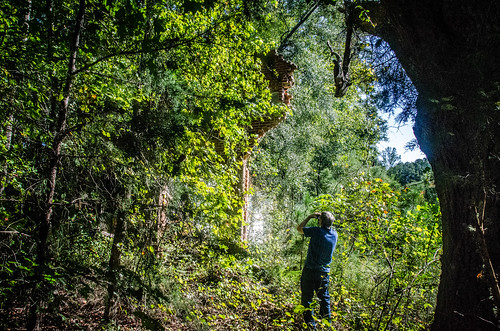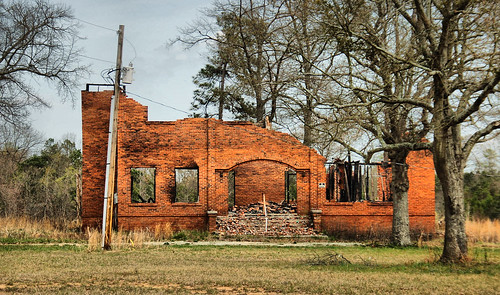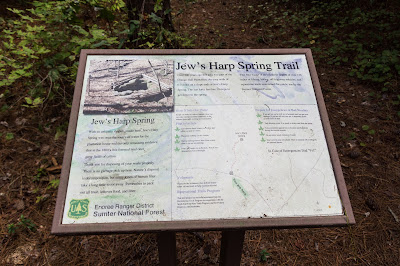The Renno Ramble
Usually when I head out to take photos of old, historic places, I already have a list of targets I've researched ahead of time because I like to be prepared. This time I only had one target in mind, the ruins of Bell's Store in the ghost town of Renno, while other targets would be decided along the way.
I recently bought Luminar 2018 as an alternative to Lightroom 5 which I've been using for a few years now. I strongly prefer owning software over renting, making paying a monthly fee to keep Lightroom working not an option for me. I tried ON1 Raw 2018.5, but found the interface a bit clunky and unintuitive for my taste. So for now, I'm using Lightroom 5 for its library functionality and Luminar 2018 to process most of my photos. I've also chosen a few of my older photos to process with Luminar 2018, one of which happened to be a February 2012 photo of Bell's Store in the ghost town of Renno in Laurens County.
I decided to post the newly processed edit of Bell's Store to the Facebook group South Carolina Picture Project. My adventuring friend Tom Taylor, in a comment, wondered if the remnants of Bell's Store were still there. I was wondering the same thing, so we decided to go visit Renno to see what, if anything, was left. The ramble was postponed once out of concern for evacuation traffic escaping Hurricane Florence, but last Wednesday we successfully visited Renno, and other places along the way.
I made the short trip to his house, made friends with his fluffy orange cat Cosmo, then soon enough we were heading south down Interstate 385 toward Laurens County.
We left the interstate to check out the community of Owins and the town of Gray Court. Tom grew up in this area and knows the area well. He pointed out interesting places along the way, some with connections to his family, including his old family home.
we found the ruins of Bell's Store well off the road. The store ruins are easy to miss this time of year if you aren't looking carefully:
Tom took photos in front of the store. Meanwhile, I went off to the right side to make a composite of the remaining intact wall:
Then I made my way out front where the old lettering is still visible:
In case you can't read it the lettering reads, "The Bells Dealers In General Merchandise".
Looks like Tom caught me in the act of taking that photo:
We made our way back to the car, then headed a short distance back up Renno Road where Renno School once stood.
This is the South Carolina School Insurance Archive photo of the school:
This is Tom's 2008 photo where the building is in the process of becoming ruins:
When I visited the school in 2012, the building was almost completely gone:
When we passed by this day, no trace of the school was visible:
A dirt road leads down and past the cemetery. The church is long gone, but the cemetery seems to be maintained. After passing through a gate, we were in.
We noticed a few graves had been chalked, probably because someone wanted to take a rubbing:
Several graves were of confederate veterans:
I found one grave marker with a signature:
Tom showed me a second grave with a signature:
The latest grave in the cemetery dates from 1977 and 1979, or at least 50 years after the small church closed.
Carver School was built in 1951 as an equalization school as a segregated elementary and high school for black students. Carver became an elementary school in 1954, a middle school in 1970. then back to an elementary school in 1979, closing in 1996. I photographed the part of school I could without trespassing, stitching together multiple photos later on to make a composite:
We continued on into Whitmire, parking near a restaurant and this ghost sign:
Tom also envied a bottle museum near the restaurant, but the museum is only open on weekends, so he had to content himself looking through the large window.
The Whitmire Cafe, at 153 Main Street, was doing good business when we entered:
We both enjoyed our meals (even more since he paid for mine. Thanks Tom!). Tom spotted this sign along the wall. My cell phone camera was out of its element here, but it's good enough:
Whitmire Truck Stop was a restaurant along U.S. 176 a short distance north of Whitmire that Tom had been to before. It turned out the waitress serving us was a relative of the lady that owned the place until she died in 2014. What a small world!
Walking back to the car, we took photos of the sidewalk advertisements. This one is intact...
while this one is not:
We headed down Coleman Avenue to the old Whitmire High School where I took this composite panorama:
We circled back around to US 176 to where the Whitmire Truck Stop building sits empty:
As we started down the trail we could see a sign:
The sign explains the area was once part of Orange Hall Plantation, a plantation that once stood a short distance away. A second sign at the spring goes into more detail about the plantation. We followed the trail the half mile or so downhill to the spring.
The second sign by the spring explains more about the Orange Hall Plantation.
Orange Hall Plantation was built in 1796 by John Rodgers, producing cotton among other products. In the spring of 1929, according to other sources, the plantation had fallen into disrepair when a tornado completely destroyed the structure. The spring supplied water for the plantation. The granite was carved in the 1860s by J. E. Sherman.
I walked down the set of steps first, giving Tom another opportunity to catch me in the act again:
The spring, at least today, was just a slow trickle.
I got out so Tom could take his turn.
Jew's Harp Spring gets it name from the granite base that strongly resembles a Jew's Harp.
Alrighty then, so what is a Jew's Harp? A Jew's Harp is a small musical instrument with a reed attached to a frame. The reed is placed in the performers mouth and plucked to produce a note.
An example of one type of Jew's Harp from Wikipedia:
The resemblance is definitely there. I found a land grant map of the area that pinpoints the location of the plantation close enough to satisfy my curiosity.
According to the map, Orange Hall Plantation was located about here on Maybinton Road:
Tom wasn't quite done here yet. According to his geocache app, one geocache was hidden near the spring. He crossed the creek and disappeared over a hill on the other side. A few minutes later, he reappeared triumphantly displaying his prize:
He replaced the geocache, and came back across the creek. We then headed back uphill toward the road. When we got back near to the road, Tom went hunting for a second geocache hidden in the area. I followed behind this time to see where this geocache was hidden. I somehow managed to spot this one first:
Tom signed the log then we returned to the car then back to Greenville.
All my photos from this trip are on an album on Google Photos.
Tom posted his photos to the album 2018-09-26 Renno Ramble on Flickr, and his blog post Renno Revisited is his take on the adventure.
I recently bought Luminar 2018 as an alternative to Lightroom 5 which I've been using for a few years now. I strongly prefer owning software over renting, making paying a monthly fee to keep Lightroom working not an option for me. I tried ON1 Raw 2018.5, but found the interface a bit clunky and unintuitive for my taste. So for now, I'm using Lightroom 5 for its library functionality and Luminar 2018 to process most of my photos. I've also chosen a few of my older photos to process with Luminar 2018, one of which happened to be a February 2012 photo of Bell's Store in the ghost town of Renno in Laurens County.
I decided to post the newly processed edit of Bell's Store to the Facebook group South Carolina Picture Project. My adventuring friend Tom Taylor, in a comment, wondered if the remnants of Bell's Store were still there. I was wondering the same thing, so we decided to go visit Renno to see what, if anything, was left. The ramble was postponed once out of concern for evacuation traffic escaping Hurricane Florence, but last Wednesday we successfully visited Renno, and other places along the way.
I made the short trip to his house, made friends with his fluffy orange cat Cosmo, then soon enough we were heading south down Interstate 385 toward Laurens County.
We left the interstate to check out the community of Owins and the town of Gray Court. Tom grew up in this area and knows the area well. He pointed out interesting places along the way, some with connections to his family, including his old family home.
Gray Court
We took no photos here, except at this former Northern and Western Railway caboose just off of West Main Street near downtown Gray Court. Tom was kind enough to let me take a few photos while he waited in the car:Tip Top Store
We left Gray Court and wandered through Martin Crossroads, through Ora (past the old Ora School), through Tylersville, by Duncan Creek Presbyterian Church, then down to the Tip Top community to visit a vine covered old store where SC 72 meets Renno Road. Tom explored this area back in 2013, but this store was new to meRenno
Off Seymour Road near where it intersects with Renno Road, ...we found the ruins of Bell's Store well off the road. The store ruins are easy to miss this time of year if you aren't looking carefully:
Tom took photos in front of the store. Meanwhile, I went off to the right side to make a composite of the remaining intact wall:
Then I made my way out front where the old lettering is still visible:
In case you can't read it the lettering reads, "The Bells Dealers In General Merchandise".
Looks like Tom caught me in the act of taking that photo:
We made our way back to the car, then headed a short distance back up Renno Road where Renno School once stood.
This is the South Carolina School Insurance Archive photo of the school:
This is Tom's 2008 photo where the building is in the process of becoming ruins:
When I visited the school in 2012, the building was almost completely gone:
When we passed by this day, no trace of the school was visible:
Stomp Springs
We went over to Stomp Springs, the site of a mineral spring and health resort in the mid-1940s to 1950s. When I last visited during the winter of 2012, the spring was clearly visible but the water looked icky and not healthy. This time the spring was overgrown, so we just kept going. At least some of the trash strewn around the place seen in 2012 had been cleaned up.Sardis Methodist Church Cemetery
We circled back to yet another site Tom has been to, but I haven't. Near the intersection of SC 72 and Stomp Springs Road is Sardis Methodist Church Cemetery, a cemetery once associated with Sardis Methodist Church that once stood nearby.A dirt road leads down and past the cemetery. The church is long gone, but the cemetery seems to be maintained. After passing through a gate, we were in.
We noticed a few graves had been chalked, probably because someone wanted to take a rubbing:
Several graves were of confederate veterans:
I found one grave marker with a signature:
Tom showed me a second grave with a signature:
The latest grave in the cemetery dates from 1977 and 1979, or at least 50 years after the small church closed.
Whitmire
We were both in the mood for some lunch so we headed for Whitmire. Before stopping for lunch, I asked if we could stop at this former equalization school off Satterwhite Road so I could get a photo.Carver School was built in 1951 as an equalization school as a segregated elementary and high school for black students. Carver became an elementary school in 1954, a middle school in 1970. then back to an elementary school in 1979, closing in 1996. I photographed the part of school I could without trespassing, stitching together multiple photos later on to make a composite:
We continued on into Whitmire, parking near a restaurant and this ghost sign:
Tom also envied a bottle museum near the restaurant, but the museum is only open on weekends, so he had to content himself looking through the large window.
The Whitmire Cafe, at 153 Main Street, was doing good business when we entered:
We both enjoyed our meals (even more since he paid for mine. Thanks Tom!). Tom spotted this sign along the wall. My cell phone camera was out of its element here, but it's good enough:
Whitmire Truck Stop was a restaurant along U.S. 176 a short distance north of Whitmire that Tom had been to before. It turned out the waitress serving us was a relative of the lady that owned the place until she died in 2014. What a small world!
Walking back to the car, we took photos of the sidewalk advertisements. This one is intact...
while this one is not:
We headed down Coleman Avenue to the old Whitmire High School where I took this composite panorama:
We circled back around to US 176 to where the Whitmire Truck Stop building sits empty:
Jew's Harp Spring
Then we made our way down Maybinton Road to Jew's Harp Spring Trail. Tom found a place to park by the roadside and we walked the short distance back to the entrance.As we started down the trail we could see a sign:
The sign explains the area was once part of Orange Hall Plantation, a plantation that once stood a short distance away. A second sign at the spring goes into more detail about the plantation. We followed the trail the half mile or so downhill to the spring.
The second sign by the spring explains more about the Orange Hall Plantation.
Orange Hall Plantation was built in 1796 by John Rodgers, producing cotton among other products. In the spring of 1929, according to other sources, the plantation had fallen into disrepair when a tornado completely destroyed the structure. The spring supplied water for the plantation. The granite was carved in the 1860s by J. E. Sherman.
I walked down the set of steps first, giving Tom another opportunity to catch me in the act again:
The spring, at least today, was just a slow trickle.
I got out so Tom could take his turn.
Jew's Harp Spring gets it name from the granite base that strongly resembles a Jew's Harp.
Alrighty then, so what is a Jew's Harp? A Jew's Harp is a small musical instrument with a reed attached to a frame. The reed is placed in the performers mouth and plucked to produce a note.
An example of one type of Jew's Harp from Wikipedia:
The resemblance is definitely there. I found a land grant map of the area that pinpoints the location of the plantation close enough to satisfy my curiosity.
According to the map, Orange Hall Plantation was located about here on Maybinton Road:
He replaced the geocache, and came back across the creek. We then headed back uphill toward the road. When we got back near to the road, Tom went hunting for a second geocache hidden in the area. I followed behind this time to see where this geocache was hidden. I somehow managed to spot this one first:
Tom signed the log then we returned to the car then back to Greenville.
Wrapup
It was a nice surprise to see Bell's Store look about the same as it did few years ago. I also enjoyed learning about Jew's Harp Spring and the Orange Hall Plantation. It was also great to go on an adventure with Tom again, as we have a few times in the past, and take advantage of his knowledge of the area.All my photos from this trip are on an album on Google Photos.
















































Comments
Post a Comment